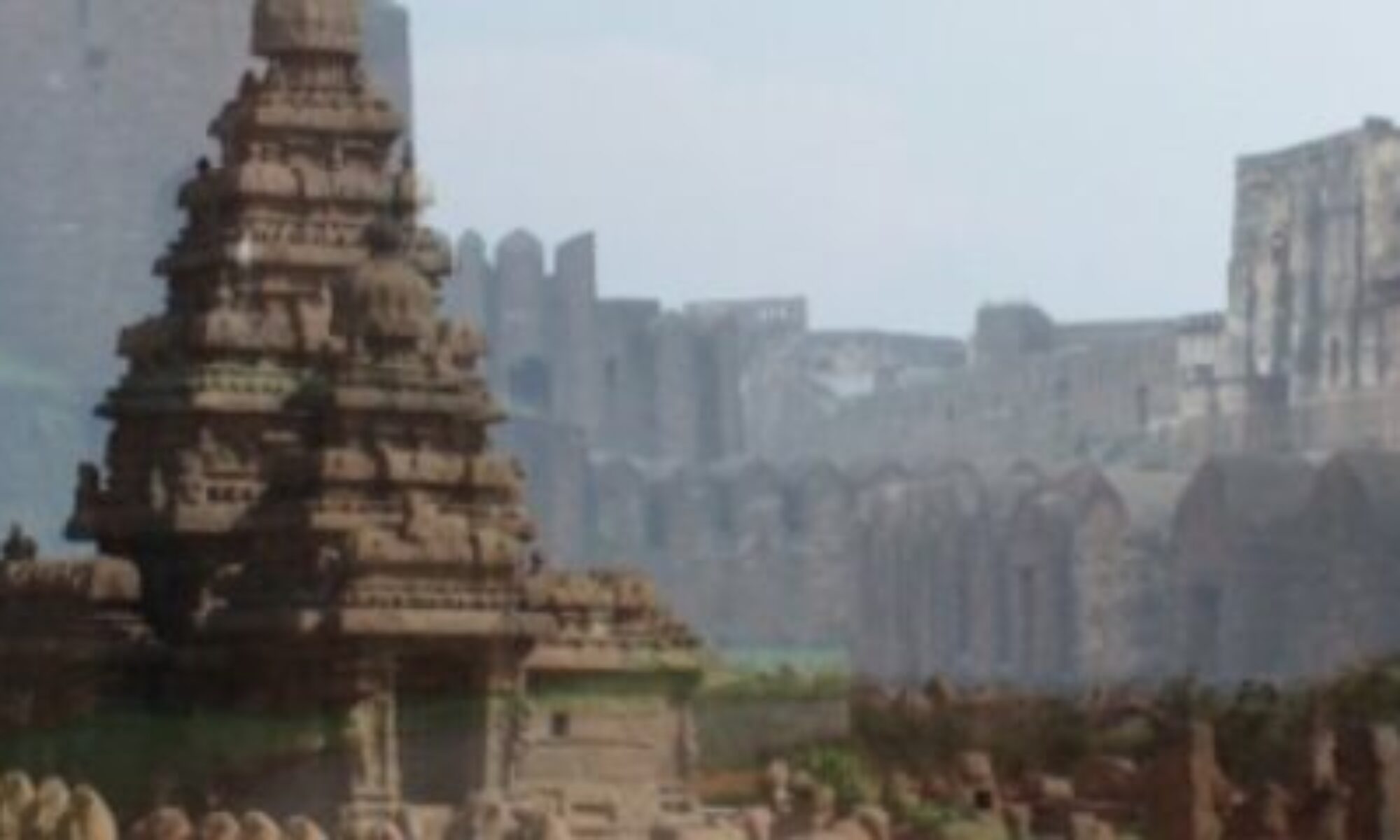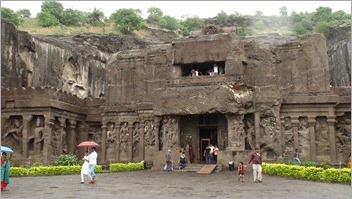 A Marvel or a Wonder are so less adjectives to describe this cave. This is the heights of rock cut carving that existed in the seventh Century. Generations over generations working for 200 years to excavate a single cave is truly astonishing. Yet, we have the result; the largest monolithic temple of the world. It is not an exaggeration to state that one can spend an entire day at this cave simply aweing at the level of detail that the artists have gone into. This is by far the most extensive and most elaborate rock-cut temple in India and most interesting as well as the most magnificent of all the architectural objects which our country possesses. I will try to be as detailed as possible without creating a boredom.
A Marvel or a Wonder are so less adjectives to describe this cave. This is the heights of rock cut carving that existed in the seventh Century. Generations over generations working for 200 years to excavate a single cave is truly astonishing. Yet, we have the result; the largest monolithic temple of the world. It is not an exaggeration to state that one can spend an entire day at this cave simply aweing at the level of detail that the artists have gone into. This is by far the most extensive and most elaborate rock-cut temple in India and most interesting as well as the most magnificent of all the architectural objects which our country possesses. I will try to be as detailed as possible without creating a boredom.
This temple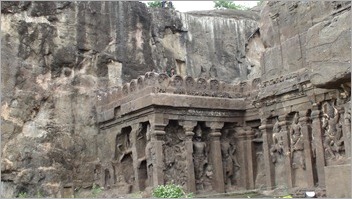 was commissioned during the rule of the Rashtrakuta King Krishna – I in the eight century and finished in the tenth. It is very interesting to note the perfection and discipline with which the excavation went on for 200 years sticking to the original plan of the layout. The temple resembles a chariot with the canopy, the driver seat and the rear part. The excavation happened top to bottom. There are two advantages of this procedure, one there is ample light for the craftsman and second, the eyes will not be affected with the stone dust It has at one time all been painted in a style befitting its elaborateness of sculpture. This painting has been renewed again and again and the most recent was painted by Rani Ahilya Devi Holker of
was commissioned during the rule of the Rashtrakuta King Krishna – I in the eight century and finished in the tenth. It is very interesting to note the perfection and discipline with which the excavation went on for 200 years sticking to the original plan of the layout. The temple resembles a chariot with the canopy, the driver seat and the rear part. The excavation happened top to bottom. There are two advantages of this procedure, one there is ample light for the craftsman and second, the eyes will not be affected with the stone dust It has at one time all been painted in a style befitting its elaborateness of sculpture. This painting has been renewed again and again and the most recent was painted by Rani Ahilya Devi Holker of 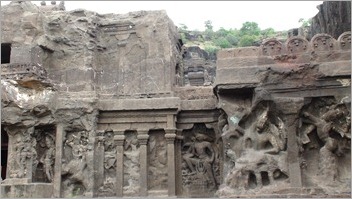 Indore in the 18th century. We can find these traces at multiple locations on the structure.
Indore in the 18th century. We can find these traces at multiple locations on the structure.
The temple stands at a great court averaging 154 feet wide and 276 long at the level of the base, entirely cut out of the solid rock, and with a scarp 107 feet high at the back. In front of this court, a curtain has been left, carved on the outside with the monstrous forms of Siva and Vishnu and their congeners, and with rooms inside it. It is pierced in 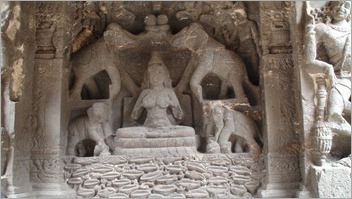 the center by an entrance passage with rooms on either side. Passing this the visitor is met by a large sculpture of Lakshmi over the lotuses with her attendant elephants as if to bless the visitors. There are some letters and a date on the leaves of the lotus on which she sits, but illegible, and probably belonging to the 15th Century. On the bases of the pilasters, have been inscriptions in characters of the 8th century, of which only some characters remain.
the center by an entrance passage with rooms on either side. Passing this the visitor is met by a large sculpture of Lakshmi over the lotuses with her attendant elephants as if to bless the visitors. There are some letters and a date on the leaves of the lotus on which she sits, but illegible, and probably belonging to the 15th Century. On the bases of the pilasters, have been inscriptions in characters of the 8th century, of which only some characters remain.
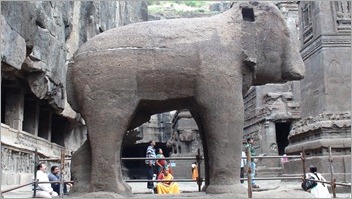 Here, we enter to the right and left, the front portion of the court which is a few feet lower than the rest, and at the right and left ends of which stand two gigantic elephants, that on the right much mutilated. Turning again to the left and ascending a few steps, we enter the great court occupied by the temple, whose base measures 165 feet in length and 109 feet wide. In front of it and connected by a bridge is a mandapa for the Nandi, and on each side of this
Here, we enter to the right and left, the front portion of the court which is a few feet lower than the rest, and at the right and left ends of which stand two gigantic elephants, that on the right much mutilated. Turning again to the left and ascending a few steps, we enter the great court occupied by the temple, whose base measures 165 feet in length and 109 feet wide. In front of it and connected by a bridge is a mandapa for the Nandi, and on each side of this 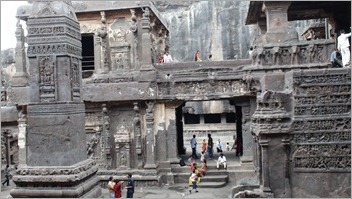 mandapa stands a pillar or the dhwajasthambha, 45 feet high, over which is the remains of a trisula making it 49 feet in total. Under the bridge, connecting the temple with the mandapa are two large sculptures – On the left is Siva as Kala Bhairava with flaming eyes and in a state of frenzied
mandapa stands a pillar or the dhwajasthambha, 45 feet high, over which is the remains of a trisula making it 49 feet in total. Under the bridge, connecting the temple with the mandapa are two large sculptures – On the left is Siva as Kala Bhairava with flaming eyes and in a state of frenzied 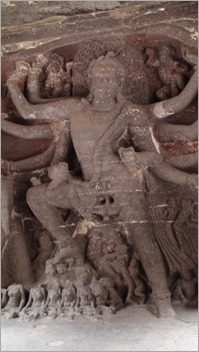 excitement, with the Saptamatrika at his feet; on the other he is represented almost exactly in the ascetic attitude of the Buddha – as Mahayogi with attendants, sages and Gods. At each side of this bridge a stair leads up to the great hall of the temple.
excitement, with the Saptamatrika at his feet; on the other he is represented almost exactly in the ascetic attitude of the Buddha – as Mahayogi with attendants, sages and Gods. At each side of this bridge a stair leads up to the great hall of the temple.
On the outer wall of the right stair is carved, in a series the entire story of Ramayana in a series of lines. The first line shows a city gate with one of the doors open and Rama, Lakshmana and Sita moving to the forests. To the extreme left of the first row, is depict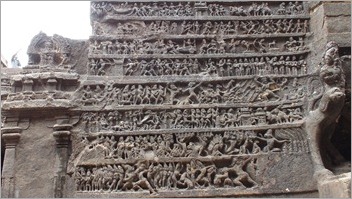 ed the three crossing the river on a boat. Center of the second row, we see the story of Lakshmana cutting off the nose of Surpanakha, the female demon and the sister of Ravana who tries to woo Rama with her charms. In the third row, in the center there is the depiction of Mareecha transformed into a golden deer and Rama and Lakshmana trying to catch it. It is believed that this scene happened in Nasik, Maharashtra. On the same row to the extreme left is the scene where Ravana kidnaps Sita in his pushpaka vimana.
ed the three crossing the river on a boat. Center of the second row, we see the story of Lakshmana cutting off the nose of Surpanakha, the female demon and the sister of Ravana who tries to woo Rama with her charms. In the third row, in the center there is the depiction of Mareecha transformed into a golden deer and Rama and Lakshmana trying to catch it. It is believed that this scene happened in Nasik, Maharashtra. On the same row to the extreme left is the scene where Ravana kidnaps Sita in his pushpaka vimana. 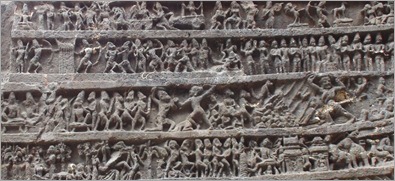
In the fourth row, there is scene of two monkeys Vali and Sugreeva fighting. On the fifth row, on the extreme right Hanuman on a mountain flying towards Lanka (the abode of Ravana) and a lady demon Sursa confronting him. On the extreme left of the Sixth row, is the scene of Asoka Vana where Sita was held captive. In the same row, the court scene of Ravana is shown where the monkey Angad increases his tail to a large coil and sits over it. Ravana is also shown in front of him with his ten heads and twenty arms. The seventh row, is depicted the scene where the monkeys are carrying stones to make a bridge over the ocean between India and Lanka. Even the waves of the ocean are depicted in a beautifully. The last, eight row shows the war scene betw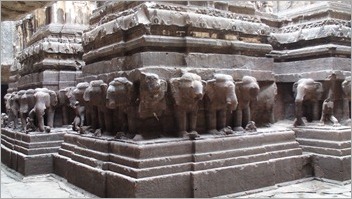 een Rama and Ravana and the latter being defeated.
een Rama and Ravana and the latter being defeated.
Behind this panel the lofty basement of the temple commences, with its row of huge elephants and Sardula (lion), feeding tearing one another, or trampling the bowels out of others etc., while apparently supporting the temple above. Here instead of the chariot wheels, these animals are shown. Elephant being the symbol of prosperity and lion, of power nicely fit into the though process of the artisans. This line is unbroken except on the right, where there had been a bridge across from a balcony of the temple to a cave, but the bridge has long since fallen.
We will continue to talk about this temple in the further post.
